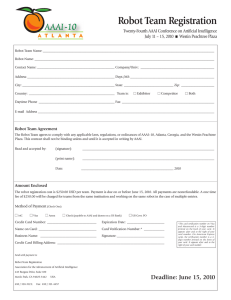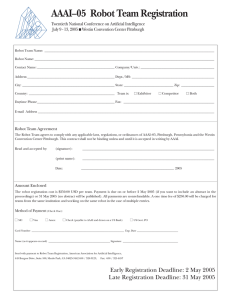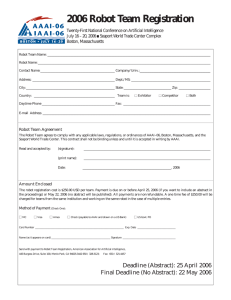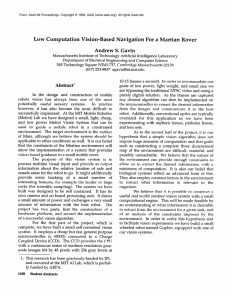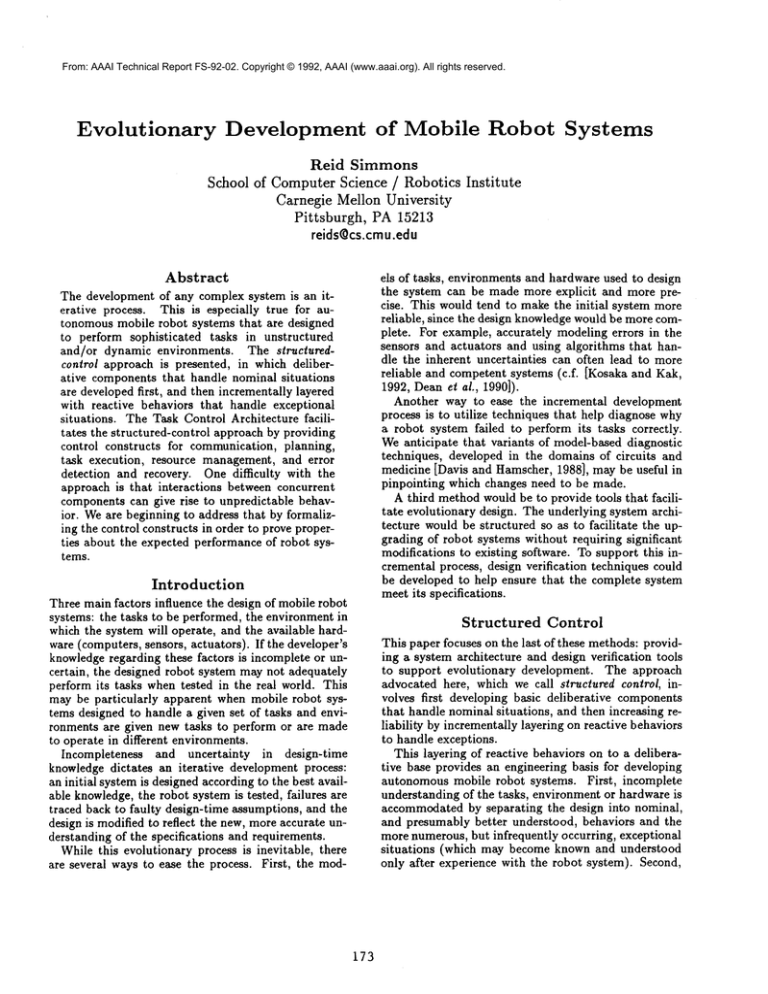
From: AAAI Technical Report FS-92-02. Copyright © 1992, AAAI (www.aaai.org). All rights reserved.
Evolutionary
Development
of Mobile
Robot
Systems
Reid Simmons
School of ComputerScience / Robotics Institute
Carnegie Mellon University
Pittsburgh, PA 15213
reids~cs.cmu.edu
Abstract
els of tasks, environments and hardware used to design
the system can be made more explicit and more precise. This would tend to make the initial system more
reliable, since the design knowledgewould be more complete. For example, accurately modeling errors in the
sensors and actuators and using algorithms that handle the inherent uncertainties can often lead to more
reliable and competent systems (c.f. [Kosaka and Kak,
1992, Deanet al., 1990]).
Another way to ease the incremental development
process is to utilize techniques that help diagnose why
a robot system failed to perform its tasks correctly.
Weanticipate that variants of model-based diagnostic
techniques, developed in the domains of circuits and
medicine [Davis and tIamscher, 1988], may be useful in
pinpointing which changes need to be made.
A third methodwould be to provide tools that facilitate evolutionary design. The underlying system architecture would be structured so as to facilitate the upgrading of robot systems without requiring significant
modifications to existing software. To support this incremental process, design verification techniques could
be developed to help ensure that the complete system
meet its specifications.
The development
of anycomplexsystemis an iterativeprocess.
Thisis especially
truefor autonomous
mobilerobotsystemsthatare designed
to performsophisticated
tasksin unstructured
and/ordynamicenvironments.
The structuredcontrolapproach
is presented,
in whichdeliberativecomponents
thathandlenominalsituations
aredeveloped
first,
andthenincrementally
layered
withreactive
behaviors
thathandleexceptional
situations.
TheTaskControl
Architecture
facilitatesthestructured-control
approach
by providing
controlconstructs
for communication,
planning,
task execution, resource management, and error
detection and recovery. One difficulty with the
approach is that interactions between concurrent
components can give rise to unpredictable behavior. Weare beginning to address that by formalizing the control constructs in order to prove properties about the expected performance of robot systems.
Introduction
Three main factors influence the design of mobile robot
systems: the tasks to be performed, the environment in
which the system will operate, and the available hardware (computers, sensors, actuators). If the developer’s
knowledgeregarding these factors is incomplete or uncertain, the designed robot system may not adequately
perform its tasks when tested in the real world. This
may be particularly apparent when mobile robot systems designed to handle a given set of tasks and environments are given new tasks to perform or are made
to operate in different environments.
Incompleteness and uncertainty
in design-time
knowledge dictates an iterative development process:
an initial system is designed according to the best available knowledge, the robot system is tested, failures are
traced back to faulty design-time assumptions, and the
design is modified to reflect the new, more accurate understanding of the specifications and requirements.
While this evolutionary process is inevitable, there
are several ways to ease the process. First, the rood-
Structured
Control
This paper focuses on the last of these methods: providing a system architecture and design verification tools
to support evolutionary development. The approach
advocated here, which we call structured control, involves first developing basic deliberative components
that handle nominal situations, and then increasing reliability by incrementally layering on reactive behaviors
to handle exceptions.
This layering of reactive behaviors on to a deliberative base provides an engineering basis for developing
autonomous mobile robot systems. First, incomplete
understanding of the tasks, environment or hardware is
accommodated by separating the design into nominal,
and presumably better understood, behaviors and the
more numerous, but infrequently occurring, exceptional
situations (which may become known and understood
only after experience with the robot system). Second,
173
From: AAAI Technical Report FS-92-02. Copyright © 1992, AAAI (www.aaai.org). All rights reserved.
this
separation
of nominalandexceptional
behaviors
increases
overall
system
understandability
by isolating
~Tr~erse Arc~~Traverse
Are)-d~
different
concerns:
therobot’s
behavior
duringnormal
operation
is readily
apparent,
andstrategies
forhanY
dlingexceptions
canbe developed
separately
andthen
addedto the existingsystemwitha mininmmof effort.Finally,
complexinteractions
are minimized
by
constraining
theapplicability
of reactive
behaviors
to
Move Body
specific
situations,
so thatonlymanageable,
predictable
subsets
of thebehaviors
willbe active
at anyonetime
(c.f.
[Firby,
1992]).
The structured-control
approachdiffersfromthe
behavior-based
approach,
in whichsystemsconsistof
.............. ~,Task
Decomposition
collections
of localbehaviors
thatactaccording
to diLegend: ~ ICommmdl~ SequentialAchievement
rectsensingof the environment
[Brooks,1986,Con¯-.g~,. Delay manning
nell,1989,Gut,1991].
Theglobal
behavior
of suchsystemstypically
emergefrominteractions
between
thelocal behaviors
[AgreandChapman,
1987,Brooks,1989,
Figure 1: Task Tree for Ambler Walking
Brooks,1991].A problemwiththe behavior-based
approachis it assumes that robust primitive behaviors
can be developed that act correctly in all, or most, situations. This can be very difficult in practice, given
behavior
usingthe TCAcontrolconstructs.
For examincomplete knowledge about the robot’s hardware and
ple,a modulecanspecifytheorderin whichsubtasks
environment. In contrast, the structured-control
apshouldbe carried
outor indicate
whenandhowto monproach advocates developing complete components for
itorforexceptional
conditions.
TCAutilizes
thisconlimited environments, and incrementally updating the
trolinformation,
in turn,to schedule
andcoordinate
design to handle more challenging and diverse requirethe actionsof othermodules.TCA has beenusedto
ments.
controlseveralautonomous
robotsystemsat CMU and
elsewhere, in particular the Ambler six-legged planeThe Task Control Architecture
tary rover [Simmons and Krotkov, 1991] and an indoor
mobile manipulator [Simmonset al., 1990].
To facilitate the structured-control approach, a develCentral to the Task Control Architecture is the conoper should be able to add new reactive and/or deliberative componentswith little or no modification to exstruction and maintenance of a hierarchical representaisting software. The Task Control Architecture (TCA)
tion of subtasks called task trees. TCAconstructs task
has been developed to facilitate this process [Simmons,
trees dynamically: nodes in the task tree are associated
with messages; when a message is issued by a module
1992a, Simmons, 1992b]. The term task-level control
that is handling a message, a child is added under the
refers to the problem of coordinating perception, planning, and actuation to achieve a given set of goals. TCA
node associated with the message being handled. In
addition to defining this hierarchical goal/subgoal deprovides a language for expressing task-level control decomposition, modules can add temporal constraints becisions and software utilities for ensuring that those contween messages, indicating (partial) orderings on their
trol choices are correctly realized by the robot.
execution.
In essence, TCAis a high-level robot operating system that provides an integrated set of commonlyneeded
Figure 1, for instance, illustrates a simplified version
control constructs. The five major types of control conof the task tree for autonomously walking the Ambler
structs supported by TCAare:
rover. In the figure, narrow vertical arrows denote task
¯ distributed communication
decomposition and heavy horizontal arrows denote tem¯ task decomposition
poral constraints on task planning and execution. The
¯ resource management
task tree basically forms the walking "plan." It indi¯ execution monitoring
cates that the Amblersequentially traverses a series of
¯ exception handling
arcs, where planning how to traverse one arc is delayed
until the previous arc has been completely traversed.
A system built using TCAconsists of robot-specific
Traversing an arc consists of taking a sequence of steps,
modules that communicate by sending messages via
a general-purpose central control module. The modwith each step consisting of a pair of leg and body
ules perform all task-dependent information processmoves. Unless the end of the arc has been reached,
ing, and the central control module is responsible for
the planning module handling the "Take Step" message
recursively issues another "Take Step" message. Note
routing messages to modules that will handle them and
that the absence of a delay planning temporal constraint
for maintaining task control information. The modules
between the "Move Body" and subsequent "Take Step"
specify control information by constraining the robot’s
174
From: AAAI Technical Report FS-92-02. Copyright © 1992, AAAI (www.aaai.org). All rights reserved.
nodes indicates to TCAthat planning one step can
occur concurrently with the execution of the previous
step. This use of concurrency enables the Ambler to
achieve nearly continuous motion [Simmons, 1992a].
Incremental
Development
TCAprovides several mechanisms that directly support
the structured-control
approach. For one, exception
handling strategies can be added incrementally without modifying existing components: a module can add
control information to an existing task tree to indicate
which procedure TCAshould invoke in response to exceptions raised by other modules. The exception handling strategies typically deal with exceptions by modifying the currently executing plan.
For example, the Ambler real-time controller monitors force sensors in the feet and raises an exception
when a threshold is exceeded (indicating unexpected
terrain contact). A separate error recovery module
handles this by modifying the current leg trajectory to
surmount the obstacle, and then instructs TCAto reexecute the trajectory [Simmons, 1992b]. If one strategy fails to solve the problem, other strategies located
higher in the task tree hierarchy are invoked until the
exception has been dealt with successfully. For example, if modifyingthe leg trajectory fails to clear the obstacle, the complete move may be replanned, the Ambler’s feet maybe shu~ed into a standard configuration,
etc.
Similarly, execution monitors can be added incrementally using the TCAwiretap control construct. The
wiretap mechanism enables a monitor to be associated
with a class of messages, so that the monitor is automatically triggered whenevera message of that class is
handled. For example, before every leg or body move
the of Ambler, a stability monitor is invoked to verify
that the movewill not cause the robot to tip over; after
every leg movea footfall monitor analyzes the force sensor data to detect possibly unstable footholds. These
monitors were added after the basic walking component
of the Ambler was designed and debugged, in order to
enable the system to handle increasingly difficult terrain.
Concurrency in perception, planning and execution
can also be added incrementally in TCAby adding and
removing temporal constraints between task tree nodes
and by managing access to robot resources (sensors,
actuators and computers). Due to the difficulties in debuggingconcurrent systems, it is often desirable to start
by designing and testing sequential systems, and then
adding concurrency as performance requirements dictate. The Ambler system, for instance, was originally
developed with a sequential sense-plan-act cycle: after
sufficient testing, the temporal constraints of the walking plan (Figure 1) were changed to permit concurrent
planning and execution [Simmons, 1992a]. Recently,
TCAwas used in making some of the perceptual processing concurrent as well [Hoffmanand Krotkov, 1991].
175
Formal Models and Design Verification
A major difficulty with both the structured-control and
behavior-based approaches is that as system complexity
increases, interactions between the componentsincrease
as well, to the point where it becomesdifficult to predict
the system’s overall behavior. This is where practice
stops and theory must take over: analytical techniques
are needed that enable developers to detect unwanted
interactions at design time, rather than waiting until
the problems manifest themselves during testing.
Weare beginning to develop such tobls for use with
the Task Control Architecture. The first step is to formalize the TCAcontrol constructs, so that their behavior and interactions can be analyzed. While the models
will not capture robot-dependent interactions (such as
a plan causing collisions between manipulator), there
are manytask-independent interactions that can be detected using such models. In particular, we anticipate
they can be used to detect temporal inconsistencies in
plan definitions, race conditions, deadlock, conditions
under which exceptions may not be handled properly,
non-termination of recursive or iterative plans, etc. Our
goal is to embed the models into a design environment
in which the various constraints on behavior can be displayed and manipulated graphically (c.f. [Erman et al.,
1988]), utilizing the analysis tools to verify the evolving
system design.
Several formal models have been proposed that may
be suitable for representing the Task Control Architecture. Petri Nets have been used to model (and coordinate) the execution of intelligent control systems, and to
prove properties about the system, such as liveness and
boundedness [Wang et al., 1991, Cao and Sanderson,
1991, Kountouris and Stephanou, 1991]. Strengths of
the Petri Net modelsare their intuitive, graphical correspondence to robot control tasks, their modular nature,
and the well-developed theory that enables system-wide
properties to be proven. The main disadvantage is that
the language is restricted. In particular, it cannot easily handle dynamic topologies of components and is not
well suited for sophisticated reasoning about time (although recently some temporal extensions to Petri Nets
have been made [Freedman, 1991]).
Temporal logics are another class of formal models that have been applied to similar reasoning and
verification tasks [Pratt, 1979, Clarke et al., 1986,
Lansky, 1987]. For our purposes, we desire a logic that
can deal with both metric and relational (ordering) aspects of time. While modal temporal logics are concise
languages for expressing temporal relationships, they
have difficulties with encoding metric time information.
On the other hand, languages such as the Duration Calculus [Chaochen et al., 1991] deal well with metric information, but are somewhat awkward for representing
purely relational aspects of time.
Weare investigating a first-order temporal logic for
representing and reasoning about TCAcontrol constructs.
The logic, based on the research of [Mc-
From: AAAI Technical Report FS-92-02. Copyright © 1992, AAAI (www.aaai.org). All rights reserved.
Dermott, 1982, Shoham, 1988, Dean and McDermott,
1987], represents time points explicitly and facilitates
reasoning about both relational and metric time. The
basic idea is that predicates such as active(msg11)
are interpreted as terms denoting sets of time points
(the times at which the associated predicate holds).
Thus, active(msg11) represents the set of points (in this
case a convex interval) during which message msg11
is actively being handled. The predicate Holds(p,t)
is syntactic sugar for t E p, and is used to indicate
that the "predicate" p holds at time point t. Thus,
Holds(active(msg11), t36) indicates that msg11 was be~
ing handled at time t36.
In this logic, the standard logical connectives are
interpreted using set-theoretic notations; for instance,
P A Q holds exactly over the intersection of the time
sets P and Q [McDermott, 1982]. The logic is sorted,
with the sorts forming a type hierarchy. In particular, messageis a type with different kinds of messages
(query, goal, command, monitor) as subtypes. Under
these are classes of messages, such as "Take Step" or
"Move Leg."
Using this temporal logic, we have begun to formalize the notion of task trees and temporal constraints
between task tree nodes. Weare starting by formalizing task trees because they are so basic to TCA. We
will then extend the model to include the other TCA
control constructs (communication, resource management, monitoring, exception handling). Weanticipate
that modelingexception handling will be fairly difficult,
since exception handlers maymodify existing task trees.
Thus, some form of non-monotonic reasoning may be
needed [Shoham, 1988].
Several axioms are presented to give a flavor of this
formalization. This is by no means a complete or final
version, and is subject to major revision by the author
at any moment.
1. After a message is sent by a module, it is added as a
child of the task tree node associated with the message (p) that the module is handling.
Vp, c : message;t,tl : time
Holds(send(p, c), tl) A (tl < t) =>
Hol ds(childO
f (p, c),
t > end(m) =¢, Holds(completed(m),
4. A message is scheduable when it is ready to be handled (it has been issued and any temporal constraints
are met). Query messages are always scheduable.
Goal, commandand monitor messages are scheduable
when the messages preceding them are completed.
Vm: query;t,tl : time
Holds(send(m), tl) A (tl < t) =>
Hol ds( scheduabl
e( m) ,
Vm, m l : goal U commandU monitor;t, t l : time
Holds(send(m), tl) A (tl < t)A
Holds(~precedes(m1,m)V completed(ml),
Holds(scheduable(
m),
5. One message precedes another when the first is constrained to be handled before the second can begin.
Vml,m2 : message;t :time
Holds(precedes(ml, m2), t) ¢:>
Holds(<(end(ml), start(m2)),
6. Wealso define the concept of when a message is being achieved. The time points ach.start(msg) and
ach.end(msg) denote the achievement interval. The
idea of achieving is the time during which all the
commandsand monitors in the subtree rooted at the
message are active (being executed). The exact semantics of achieving are detailed in the next several
axioms.
7.
.
Vm : message; t : time
ach.start(m) < ach.end(m)A
ach.start(m) < t < ach.end(m)
Holds(achieving(m),
A command or monitor message is being achieved
exactly when it is active. A goal messages can start
being achieved after it is active, and continues being
achieved at least until the message is completed.
Vm : command U monitor
start(m) = ach.start(m) A end(m) = ach.end(m)
Vm: goal
start(m) < ach.start(m) A end(m) < ach.end(m)
A messageis being achieved at least while all of its
children are being achieved.
Vp, c : goal U commandU monitor; t : time
Holds( chil dOf (p, c ) , t)
Holds(<(ach.start(p), ach.start(c) t)A
Holds(<
( ach.end(c), ach.end(p)
2. A message is active when it is being handled by a
module. The time points start(msg) and end(msg)
denote the ends of the interval during which the message is active (strictly speaking, the relational predicates, such as <, should be written using the Holds
notation; for clarity, this is suppressed).
Vm: message; t : time
start(m) < end(m)A
start(m) < t < end(m) ~ Holds(active(m),
3. A messageis completed after it is active.
Vm: message; t : time
The purpose of the formalization is to prove properties about the Task Control Architecture, in general,
and about specific robot systems that use TCA. For
example, the intent of the sequential achievement constraint is that all commandsand monitors in the first
subtree should precede any of those in the second (Figure 1). TCAimplements sequential achievement using
the constraint ach.end(ml) < ach.start(m2). Weoutline a proof below showingthat this does in fact implement the intended control construct.
More formally, we want to prove that
Vml, m2 : goal, m3, m4 : commandU monitor; t : time
Holds( SeqAch(ml, m2)A
desc(ml, m3) A desc(m2, m4), t)
1While it is probably cleaner to have Holds apply to
intervals of time, rather than points, as [Shoham, 1988]
does, wewill use the simplerformulationhere for illustrative
purposes.
176
From: AAAI Technical Report FS-92-02. Copyright © 1992, AAAI (www.aaai.org). All rights reserved.
Holds(precedes(m3, rn4 ),
where desc is the "descendant" relationship:
Hoids(dese(ane, msg), t)
nolds(childOf(ane, msg), t)V
3m2[Holds(ehildOf(anc,
m2)^ dese(m2,m), t)]
From the definition of precedes (5), we need to show
that end(m3) < start(m4). From (7), it suffices to show
that ach.end(m3) <_ ach.start(m4), since both m3 and
m4 are either command or monitor messages. To do
this, we will show that ach.end(m3) < aeh.end(ml)
and ach.start(m2)
< ach.start(m4).
Then from the
definition of the sequential achievement constraint and
transitivity we get the desired proof.
To show ach.end(m3) < aeh.end(ml), we do a case
analysis of the desc relation. If m3 is an immediate child of ml (first disjunct), then the result follows immediately from (8). If m3 is a descendant
of some immediate child (c) of ml (second disjunct),
then ach.end(c) < ach.end(ml) from (8). By induction, ach.end(m3) < ach.end(c), so by transitivity the desired "achieving" relationship holds between
ml and m3. A similar argument can be used to show
ach.start(m2) < aeh.start(m4). Thus, the sequential
achievement constraint in TCAachieves its desired purpose: ensuring that the commandand monitor messages of one subtree completely precede those of another
(note that this result does not hold for goal messages;
this is intentional, in order to enable planning in advance of execution).
Wecan also prove properties about the performance
of specific robot systems. For example, we could show
that the temporal constraints described in [Simmons,
1992a] are sufficient to ensure that the Amblerwalking
system will plan at most one step in advance. To ensure
that it will plan at least one step in advance, however,
we need to utilize metric information about the relative
durations of the various planning, sensing and actuation
steps. The logic we are advocating is well suited for
this purpose, and we intend to extend our methods to
handle metric cases as well.
Conclusions
The structured-control approach provides a principled
methodology for the evolutionary development of complex mobile robot systems. Due to uncertainties and incomplete knowledge of the robot’s tasks, environment
and hardware, an iterative approach is advocated in
which components that handle nominal situations are
developed and tested first, and then reactive behaviors that handle exceptional situations are incrementally added to increase safety, reliability and competence. The Task Control Architecture supports the
structured-control approach by enabling reactive components to be added to robot systems with little or no
modification to existing software.
While TCA and the structured-control
approach
have proven useful, in practice developing complex
autonomous mobile robot systems is still a time-
177
consuming and very heuristic process. Wehope to go
beyond the trial-and-error
method of development by
formalizing the TCAcontrol constructs and by providing tools for analyzing designs formed from collections
of interacting components. Wehave investigated several formalisms, including Petri Nets and temporal logics, and have settled (for now, at least) on a first-order
temporal logic, due to its expressiveness in representing
both relational and metric temporal information. While
the formalization process is still preliminary, results to
date are encouraging.
Weare moving toward formalizing all the TCAcontrol constructs. This will enable us to reason about such
things as communication delays, resource contention
and deadlock, expected system performance, the ability of the robot to detect and recover from errors, etc.
While currently proofs of system properties are done
by hand, we hope to automate some of the reasoning
processes eventually. As mentioned earlier, formalizing
the way task trees are modified during replanning is
likely to be difficult, due to its non-monotonicnature.
Weneed to find good ways of addressing this, however,
since task tree modification is a critical aspect of the
structured-control approach.
A crucial hypothesis in our approach is that robot
systems can be constructed and analyzed as collections
of interacting deliberative and reactive components. In
addition, it is assumed that the TCAcontrol constructs
are sufficient for constraining the behavior of the systems to eliminate all undesirable interactions between
components. Wehope that experience developing additional TCA-based mobile robot systems and results
from our formalization efforts will provide positive support of that hypothesis.
Acknowledgments
Many thanks to Chris Fedor who implemented much
of TCA, and members of the Planetary Rover project
who have developed the Ambler and its autonomous
walking system. Thanks also to David Garlan for many
useful ideas and discussions. This research is supported
in part by NASAunder Contract NAGW-l175and by
OSDunder Contract F08635-92-C-0019.
References
[Agre and Chapman, 1987] Phil Agre and David Chapman. Pengi: An implementation of a theory of activity. In Proc. National Conference on Artificial Intelligence, pages 268-272, Seattle, WA,1987.
[Brooks, 1986] Rodney Brooks. A robust layered control system for a mobile robot. 1EEE Journal of
Robotics and Automation, RA-2(1), 1986.
[Brooks, 1989] Rodney Brooks. A robot that walks:
Emergent behavior from a carefully evolved network.
Neural Computation, 1(2):253-262, Summer1989.
[Brooks, 1991] Rodney Brooks. Intelligence without
reason. In Proc. International Joint Conference on
AI, Sydney, Australia, August 1991.
From: AAAI Technical Report FS-92-02. Copyright © 1992, AAAI (www.aaai.org). All rights reserved.
[Caoand Sanderson, 1991] Tiehua Cao and Arthur
Sanderson. Automatic decomposition of assembly
sequence plans. In Proc. Third Annual Conference
on Intelligent Robotic Systems for Space Exploration,
pages 19-28, RPI, Troy, NY, November 1991.
[Chwochenet ai., 1991] Zhou Chnochen, C.A.R. Hoare,
and Anders Ravn. A calculus of durations. Technical
report, ProCoS, February 1991.
[Clarke et aL, 1986] Edward Clarke, E. Emerson, and
A. Sistla. Automatic verification of finite-state concurrent systems using temporal logic specifications.
ACMTransactions on Programming Languages and
Systems, 8(2):244-263, April 1986.
[Connell, 1989] John Connell. A behavior-based arm
controller.
IEEE Journal of Robotics and Automation, 5(6):784-791, 1989.
[Davis and Hamscher, 1988] Randall Davis and Walter
Hamscher. Model-based reasoning: Troubleshooting.
In H. Shrobe, editor, Exploring Artificial Intelligence,
chapter 8, pages 297-346. Morgan Kaufman, San Mateo, CA, 1988.
[Dean and McDermott, 1987] Tom Dean and Drew
McDermott. Temporal data base management. Artificial Intelligence, 32(1):1-55, 1987.
[Dean et al., 1990] TomDean, Kenneth Basye, Robert
Chekaluk, Seungseok Hyun, Moises Lejter, and Margaret Randazza. Coping with uncertainty in a control system for navigation and exploration. In Proc.
National Conference on Artificial Intelligence, pages
1010-1015, Boston, MA, 1990.
[Erman et aL, 1988] L. Erman, J. Lark, and F. HayesRoth. Abe: An environment for engineering intelligent systems. IEEE Transactions on Software Engineering, 14(12):1758-1770, December1988.
[Firby, 1992] R. James Firby. Building symbolic primitives with continuous control routines. In AI Planning Systems, College Park, MD,June 1992.
[Freedman, 1991] Paul Freedman. Time, petri nets,
and robotics. IEEE Transactions on Robotics and
Automation, 7(4):417-433, August 1991.
[Gat, 1991] Erann Cat. Reliable Goal-Directed Reactive
Control of Autonomous Mobile Robots. PhD thesis,
Jet Propulsion Laboratory, July 1991.
[Hoffman and Krotkov, 1991] Regis Hoffman and Eric
Krotkov. Perception of rugged terrain for a walking robot: True confessions and new directions. In
Proc. of the International Workshop on Intelligent
Robots and Systems, pages 1505-1510, Osaka, Japan,
November 1991.
[Kosaka and Kak, 1992] Akio Kosaka and Avi Kak.
Fast vision-guided mobile robot navigation using
model-based reasoning and prediction of uncertainties. In Proc. 1EEEInternational Workshopon Intelligent Robots and Systems, pages 2177-2186, Raleigh,
NC, July 1992.
[Kountouris and Stephanou, 1991] V. G. Kountouris
and H. E. Stephanou. Dynamic modularization and
synchronization for intelligent robot coordination:
The concept of functional time-dependency. In Proc.
IEEE International Conference on Robotics and Automation, pages 508-513, Sacramento, CA, April
1991.
[Lansky, 1987] AmyLansky. A representation of parallel activity based on events, structure and causality. In M. Georgeoff and A. Lansky, editors, Reasoning About Actions and Plans, pages 123-160. Morgan
Kaufmann, 1987.
[McDermott, 1982] Drew McDermott. A temporal
logic for reasoning about processes and plans. Cognitive Science, 6:101-155, 1982.
[Pratt, 1979] V. R. Pratt. Process logic. In Proc. 6th
POPL, pages 93-100, January 1979.
[Shoham, 1988] Yoav Shoham.
Reasoning About
Change: Time and Causation from the Standpoint
of Artificial Intelligence. MITPress, 1988.
[Simmons and Krotkov, 1991] Reid Simmons and Erie
Krotkov. An integrated
walking system for the
Ambler planetary rover. In Proc. IEEE International Conference on Robotics and Automation,
pages 2086-2091, Sacramento, CA, April 1991.
[Simmonset al., 1990] Reid Simmons, Long Ji Lin, and
Chris Fedor. Autonomous task control for mobile
robots. In Proc. IEEE Symposium on Intelligent
Control, Philadelphia, PA, September 1990.
[Simmons, 1992a] Reid Simmons. Concurrent planning
and execution for autonomous robots. IEEE Control
Systems, 12(1):46-50, February 1992.
[Simmons, 1992b] Reid Simmons. Monitoring and error
recovery for autonomous walking. In Proc. IEEE International Workshop on Intelligent Robots and Systems, pages 1407-1412, July 1992.
[Wang et aL, 1991] Fei Yue Wang, Konstantinos J.
Kyriakopoulos, Anthanasios Tsolkas, and George N.
Saridis. A petri-net coordination model for an intelligent mobile robot. IEEE Transactions on Systems,
Man, and Cybernetics, 21(4):777-789, July/August
1991.
178

